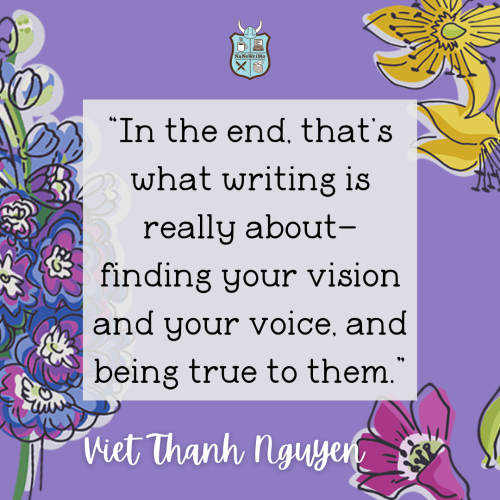Chris Baty's Blog, page 12
March 24, 2023
4 Steps to Making Each NaNoWriMo Event Your Own

While many people look forward to the 50K challenge in November, our upcoming Camp NaNoWriMo challenge in April can be a good time to try a new kind of writing project or set a goal of your own. If you’re looking for tips on personalizing your NaNo experience, NaNo Participant StephanieBraxton has some advice!
NaNoWriMo is known for being the Write 50,000 Words in 30 Days challenge. Like many things in life, National Novel Writing Month, and all of its accompanying events throughout the year, are what you make of them.
I’ve always been someone who liked writing by hand. As I’ve gotten older, I’ve found more convenience for the habit of writing in a composition book than a laptop. That is how I tackle NaNoWriMo three times a year, with a cheap Papermate pen and a $1 black and white composition notebook. I set my own goal, which is often dependent on what’s going on in my life at the time and what project I’m working on. Ifyou find yourself enchanted by the community and atmosphere around this challenge, but you’re scared or unable to commit to November’s 50k challenge, maybe try it another way. There are some things you’ll needto do first though.
1. Figure out your normal.
No matter how you write, find what is a normal and easy pace for you. For me, I can usually do 30 pages handwritten in 30 days, easy. That is my normal, average pace. It is the baseline from which I figure out how I can challenge myself.
2. Decide how much to challenge yourself.
This part may take some trial and error. You may have to adjust your goal if you realize the original one is not working. Even though I conquered a 75 page goal in the past, sometimes life is being crazy or the story itself is not cooperating, and I’ll have to lower my goal to 50 pages. The flip side of that is what happened to me last November, when I started out with a 50 page goal and ended up writing 78 pages.
3. Find ways to give yourself a boost.
I take my writing everywhere. I’ve written in the car while waiting at the dentist. I’ve taken a book light and attached it to my notebook, and written in the floor of mykids’ bedroom while I’m waiting for them to go to sleep. It doesn’t always work, but when something is important, we can find time for it.
4. Realize that each NaNoWriMo event is different.
It can be discouraging when you see people who commit to this challenge every year always hitting 50,000 words. Do not let that stop you from trying. Social media contributes to this falsehood that we should be able to do everything at 100% all the time, and that is just not always the case. I’ve had some epic flops of NaNoWriMos, but then I’ve come back to the challenge the next time and nailed my goal. Like writing itself, it has highs and lows.
Though I’ve had some good non-NaNoWriMo writing months, I find this challenge gets me to do more than I would any other time. Even being a rebel who always does handwritten and always does page goals instead of word count, I would not change the November event at all. Honoring the original idea that created NaNoWriMo isn’t stopping me from making thischallenge my own. In my opinion, the spirit of the event is just toget to writing, and that’s what it does for me, nearly every time.
I hope as April approaches, you feel that magic in the air that makesall writers put fingers to keyboard or pen to paper.
Happy Writing!

Stephanie Braxton is a working mama of two, married to a Forever DM of Dungeons and Dragons. Daylighting as an administrative assistant for anon-profit focused on adult literacy, she writes whenever andwherever she can purely for the joy of it.
Photo by Andrea Piacquadio from Pexels
March 23, 2023
Three Ways to Pull from Within to be Authentic and Real in Your Writing

Writers are often told to write what they know, but what does that actually mean? NaNo participant Najla gives tips on how to to be authentic in your writing.
I used pull in the title of this post because that’s what it felt like for me as a new writer to reach inside, yank out my pulsating heart, trudge up deep memories and conversations that I packed away, and be real in my writing.
It can mean a lot of things to different people but for me, it means finding those raw, honest moments in my life that only I know and immersing those hidden things in my writing.
For many writers, we invite readers into our world to tell untold and interesting stories. We explore themes like hardships, struggle,inequality, conflict, misunderstandings, heartache, injustice,despair, growth, success, failure, and much more.
To add more depth to your stories and characters, consider leaning into your own experiences and past.
So, how can you use your personal life to be more real in your writing?
Start by asking yourself the following questions:
1. Have you ever felt or experienced hardship, struggle, misunderstanding, or failure?
Of course, you have. Pick a life experience and reflect on what led up to that event. What did you feel during it? How did you or someone else change because of it? Write that down.
2. What conversations were a part of these experiences?
Were they calm discussions, heated arguments, sobbing ugly cries, uncomfortable admissions, inconsiderate digs, or relentless back and forth comments? Write those down.
3. What were other people’s responses?
Did they face the challenge, endure, run away, make excuses, lie, betray themselves or others, move to another place, do something drastic, or go silent? Write all that down.
If you’re having trouble coming up with something, pause and reflect on the some of following relationships and people that may have come into your life:
A classmate in school who had it out for you or competed with youA teacher, coach, or mentor or adult who offered tough loveA friend or coworker or boss you parted ways withA distant or close sibling or cousin you disagreed withA disapproving family memberA person or relationship you grievedSomeone you relied on or who relied on youA couple things to keep in mind:
1. Your characters don’t have to be anything like you to use this approach.
The goal is to make your writing more real, honest, and authentic. Most people, no matter what they believe or think, have had an unfulfilled relationship, a disappointing experience, or a major disagreement with someone in their lives.
2. You don’t have to apply the experience or conversation you had to the same situation for your character.
For example, your character may need to have a terrible argument with a sibling but you may draw from one that you had with a partner or spouse. But maybe a similar impetus can be used to start the argument. Perhaps the dialogue can draw from real words or phrases used. Or the resolution or lack of resolution may look and feel similar to what you experienced.
3. Your characters don’t have to have similar personalities or responses to you, but can be bothered by the things that get under your skin or bug you.
As an example, think about how you handle it when someone cuts you off in traffic or steps in front of you in a line. Do you sneer or curse or let the person glide in?
Literary agent, Kat Kerr, once said that common vernacular is not so common.
Vernacular is a reflection of your own background and experiences, use your life as a way to draw out some real intense and emotional moments in your writing.
Oh and don’t forget to share what you write with me!

Manager of projects by day: Lyrical bandit by night;
Mom of Two Cool Kids and a Corgi named Cookie.
Najla writes historical fiction about fascinating people in history because real life makes for the best fiction! Her current search history is filled with questions like “When was Chanel No. 5 invented?” and “When did the newsboysstop?”
Follow Najla on Instagram, Facebook, and TikTok
Header Photo by Tran Le Tuan from Pexels
March 16, 2023
NaNoWriMo Pep Talker Book Bracket, Round 1.4
This year for Women’s History Month, we’ve dug into our Pep Talk archives to find some of our favorite books written by women and featuring a strong female protagonist. In the spirit of March Madness, here’s a just-for-fun book bracket featuring eight of our favorites. Here’s the full post!
Round 1, Option 4:
With the Fire on High by Elizabeth Acevedo
A Deadly Education by Naomi Novik
NaNoWriMo Pep Talker Book Bracket, Round 1.3
This year for Women’s History Month, we’ve dug into our Pep Talk archives to find some of our favorite books written by women and featuring a strong female protagonist. In the spirit of March Madness, here’s a just-for-fun book bracket featuring eight of our favorites. Here’s the full post!
Round 1, Option 3:
The Hero and the Crown by Robin McKinley
Victories Greater Than Death by Charlie Jane Anders
NaNoWriMo Pep Talker Book Bracket, Round 1.2
This year for Women’s History Month, we’ve dug into our Pep Talk archives to find some of our favorite books written by women and featuring a strong female protagonist. In the spirit of March Madness, here’s a just-for-fun book bracket featuring eight of our favorites. Here’s the full post!
Bracket 1, Option 2:
Pachinko by Min Jin Lee
The Hundred Thousand Kingdoms by N.K. Jemisin
NaNoWriMo Pep Talker Book Bracket, Round 1.1
This year for Women’s History Month, we’ve dug into our Pep Talk archives to find some of our favorite books written by women and featuring a strong female protagonist. In the spirit of March Madness, here’s a just-for-fun book bracket featuring eight of our favorites. Here’s the full post!
Bracket 1, Option 1:
Alanna: The First Adventure by Tamora Pierce
Cinderella is Dead by Kalynn Bayron
Book Bracket: Favorite Novel by a NaNoWriMo Pep Talker

Did you know that nearly 70% of NaNoWriMo writers are women? This year for Women’s History Month, we’ve gone through our list of NaNoWriMo Pep Talkers to find some of our favorite books written by women and featuring a strong female protagonist. In the spirit of March Madness, here’s a just-for-fun book bracket featuring eight of our favorites. Which is yours?
To vote, choose your favorite on each individual poll that will be posted separately and linked below. We’ll tally up the votes for all three rounds to find out which book you all like best!
We think all of these books are fantastic, and you should check them all out. If you want to see our full list of Pep Talk authors and read their inspiring messages, you can find them at https://nanowrimo.org/pep-talks
Round 1:
Alanna: The First Adventure by Tamora Pierce vs. Cinderella is Dead by Kalynn Bayron: Vote in Poll 1.1
Pachinko by Min Jin Lee vs. The Hundred Thousand Kingdoms by N.K. Jemisin: Vote in Poll 1.2
The Hero and the Crown by Robin McKinley vs. Victories Greater Than Death by Charlie Jane Anders: Vote in Poll 1.3
With the Fire on High by Elizabeth Acevedo vs. A Deadly Education by Naomi Novik: Vote in Poll 1.4
March 9, 2023
Announce Your Camp NaNoWriMo Project!

The official Camp NaNoWriMo challenge starts on April 1! Camp NaNoWriMo is a virtual writing retreat where you can set your own focused writing goal for the 30 days of April, complete with knowledgeable counselors, fun activities, and groups of both new and old friends.
How does it work?1. Decide on a Goal — During Camp, you can set your own word-count goal (you’re not locked into 50,000 words!), and you can officially tackle any kind of writing project, novel or not. If you want to track a non-word goal like time or pages, here’s a handy conversion chart.
2. Announce Your Project — You have two options for Camp: set a goal for a brand new project, or set a goal for a project you’ve already started. Just be sure to check “Associate with a NaNoWriMo event” and select the current Camp NaNoWriMo event. You’ll be able to start updating your word count when Camp officially begins on April 1!
3. Prepare to Write — You can use Camp to work on any kind of writing project, so check out our Camp Tracks and decide which resources are most useful to you!
Published authors will act as your Camp Counselors, sending advice in Camp Care Packages throughout April. Plus, keep an eye on HQ’s virtual events for a packed schedule of Virtual Write-Ins, webcasts, Zoom meetups, and more.
March 3, 2023
The Art of the Pitch

When submitting your manuscript to an agent, your pitch letter is the first thing they read. But with hundreds of emails pouring into agents’ inboxes every day, how do you get yours to stand out? Author Jeff Herman has some tips:
On any given day, there’s a massive surplus of desperate manuscripts clamoring to fill way too few opportunities. It resembles hordes of famished zombies ripping at the walls and doors where a remnant of agents and editors have found sanctuary. This helps explain why the barriers to your success seem to be unreasonably extreme, not to mention insensitive and discourteous. The harsh process is a form of self-preservation for the gatekeepers. However, access is possible; sometimes you just have to reframe what you’re seeing.
Countless manuscripts that merit publication will spend eternity in the clouds because the authors failed to get agents and editors to read them. From the perspective of the gatekeepers, unsolicited manuscripts are a burden until proven otherwise; they’re an ever-accumulating digital landfill that’s humanly impossible to process and cope with, or even think about. But it’s within every writer’s power to change the math for themselves.
The following guidance doesn’t promise to be the cure, but it does promise to meaningfully elevate the odds that your manuscript will be requested and read. My advice is the consequence of reading more than one-million pitches covering everything you can imagine.
1. Don’t be boring. Boredom causes attention to shut down. The letter should be as entertaining, compelling, and alluring as the body of work you want to read. Too many writers treat their pitch letters like job applications; imagine having to read hundreds of those a day.
2. Don’t waste space. Avoid filler. Keep to a single page with short paragraphs (eyes detest densely packed sections).
3. Use lively and relatable descriptions. Make descriptive lines count with language that transmits visceral and dynamic images. Imagine movie trailers.
4. Get to the point by the second line. Don’t wander into the weeds or try to be a pen pal.
5. Say exciting things about yourself. For example, “I’m a third-generation serial killer.” Or, “I’m a former President of the United States.” (However, only share things that are true!)
6. Don’t compare your work to bestsellers. It might make you appear arrogant or grandiose. Do a little research to find the titles that best match your work.
7. Don’t reveal how many years you’ve been trying to get someone to read your pitch, let alone your work. Don’t reveal how many thousands of times you’ve been rejected so far. Don’t expect strangers to care about your aspirations from the goodness of their hearts.
8. Be softly immodest. Show you’re a winner in ways that say it for you. Highlight your accomplishments, don’t hide them. Success tends to gravitate to people who know how to personify a successful image.
9. Don’t stereotype yourself in ways that could undermine your chances. For instance, there’s no reason to say your age unless it’s germane to the book. (Ageism is frequently an elephant in the room, and unfortunately, publishing isn’t an exception.)
10. Keep trying. Consistently showing up and doing the work regardless of how you feel will get you far. Writing and publishing is a game of long ball that rewards tenacity and resilience.
Jeff Herman is the author of Jeff Herman’s Guide to Book Publishers, Editors & Literary Agents, 29th Edition and coauthor of the acclaimed Write the Perfect Proposal. He has presented hundreds of workshops about writing and publishing and has been interviewed for dozens of publications and programs. His literary agency has ushered nearly 1,000 books into publication, including many bestsellers. He lives in Stockbridge, MA. His website is www.JeffHerman.com.
Based on the book Jeff Herman’s Guide to Book Publishers, Editors & Literary Agents, 29th Edition. Copyright ©2023 by Jeff Herman. Published by New World Library — www.newworldlibrary.com.
Top photo by Andrew Dunstan on Unsplash.
February 24, 2023
Are you writing this month? Check out our “I wrote a novel… now...

Are you writing this month? Check out our “I wrote a novel… now what?” resources over on the NaNoWriMo website for tips on choosing your next writing adventure: whether that’s finishing a story you’ve been working on for a while, editing and revising, pursuing publishing… or something completely different! For some extra inspiration, author Viet Thanh Nguyen’s Pep Talk from this past November will help you find your voice and vision. Read the full Pep Talk here!
Image description: A purple background with illustrated pink, yellow, and purple flowers, with text that reads: “In the end, that’s what writing is really about—finding your vision and your voice, and being true to them.” —Viet Thanh Nguyen
Chris Baty's Blog
- Chris Baty's profile
- 63 followers



